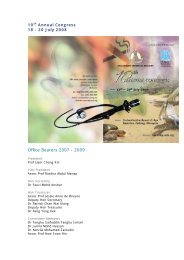download - Malaysian Thoracic Society
download - Malaysian Thoracic Society
download - Malaysian Thoracic Society
Create successful ePaper yourself
Turn your PDF publications into a flip-book with our unique Google optimized e-Paper software.
Annual Congress of <strong>Malaysian</strong> <strong>Thoracic</strong> <strong>Society</strong><br />
Symposium 4B<br />
Air-Travel Related Disorders<br />
Managing patients who require oxygen during air travel<br />
Norhaya Mohd Razali<br />
Hospital Sultanah Nur Zahirah, Kuala Terengganu, Terengganu, Malaysia<br />
Travelling by air whether for going on a holiday or for some other purposes, precautions should be taken while<br />
flying. Air travel has no wrong or significant effect on health. However, it is a well known fact that travelling<br />
long distances in a pressurized cabin altitude does have some effects on the human body.<br />
Air travel may pose a special form of altitude problem since almost all commercial aircraft fly above 21,000<br />
feet. Aircraft cabins are normally pressurized at a maximum of 8,000 feet (2438m). The falling barometric<br />
pressure with increasing altitude results in a drop in arterial oxygen tensions (PaO2). However, air travel<br />
offers many advantages for heart and lung patients since it is quick and involves little activity.<br />
In general, airlines do allow oxygen to be used but require considerable forethought and planning. Arrangements<br />
must be made in advance and most airlines require a doctor’s letter. A physician’s statement of oxygen needs<br />
in order to fly in a commercial flights must be made available. Patients/passengers cannot bring their own<br />
oxygen on board, oxygen supplied by the airline must be used. Requirements vary from carrier to carrier but,<br />
they all require arrangements be made in advance and they all charge for in flight oxygen.<br />
The airlines’ position on routine use of their oxygen in the transport of patients is that they are not in the<br />
business of transporting sick people. There are unique liability problems in so doing and regulations which<br />
must be followed when they act in the position of an air ambulance.<br />
Patients with respiratory disorders such chronic obstructive pulmonary disease (COPD), cystic fibrosis,<br />
asthma, or heart disease and need oxygen supply, they should be able to travel via air so long as they consult<br />
closely with their physician and then follow the advice received.<br />
For COPD patients, whose main problem is moving air in and out of their lungs, getting sufficient oxygen is<br />
vital. Therefore, it is important that nothing be undertaken which inhibits its function. When travelling by car,<br />
train, or bus, COPD patients and others needing supplementary oxygen should have a supply available in case<br />
they pass through areas of excess air pollution. They should also avoid travel in a confined area, such a bus<br />
where smoking in permitted, and ensure that they keep out of extreme temperatures, both hot and cold.<br />
References<br />
1. Aina Akero, Carl C. Christensen, Anne Edvardsen et al. Pulse oxymetry in the Preflight Evaluation of Patients with Chronic<br />
Obstructive Pulmonary Disease. Aviation, Space and Environmental Medicine. Vol. 79. No. 5. May 2008<br />
2. Medical Guidelines For Airline Travel 2nd Edition. Aerospace Medical Association Medical Guidelines Task Force, Alexandria, VA<br />
3. J. Micheal Muhm. Predicted Arterial Oxygen at Commercial Aircraft Cabin Altitudes. Aviation, Space, and Environmental Medicine.<br />
Vol. 75, No. 10. October 2004<br />
4. Communication: Dr. Daljit Singh Parmar, Head of Corporate Occupational Safety and Health (COSH), Senior Manager Medical<br />
Services, <strong>Malaysian</strong> Airlines System<br />
37








